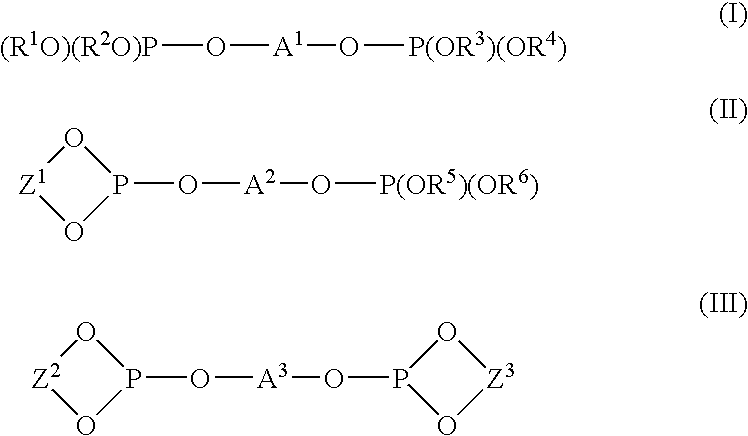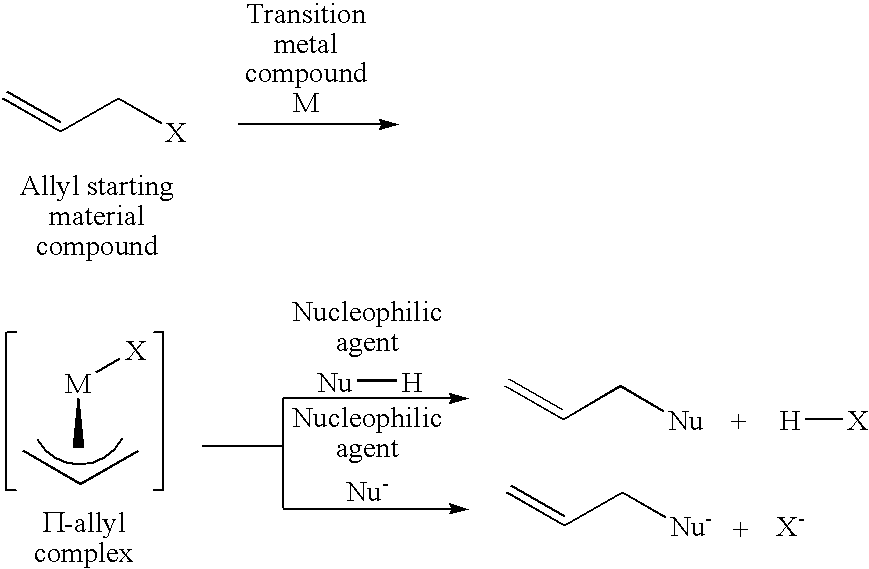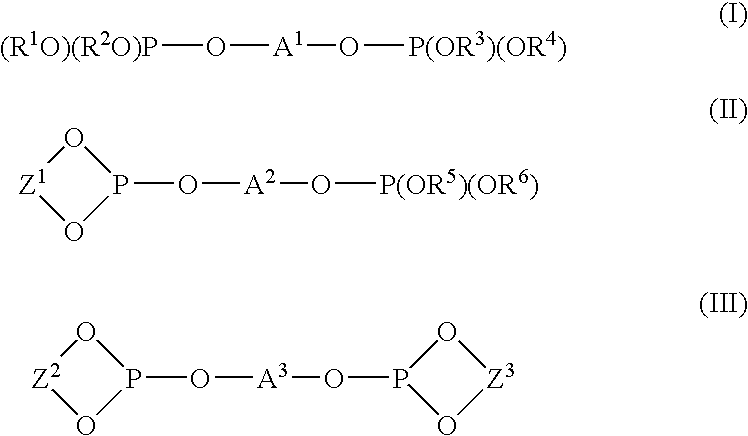Method for producing allyl compound, and allyl compound produced thereby
a technology of allyl compound and allyl compound, which is applied in the direction of ether preparation, organic chemistry, chemistry apparatus and processes, etc., can solve the problems of insufficient attack force of such a nucleophilic agent, inability to achieve satisfactory thermal stability, and inability to meet the requirements of high temperature reaction achieving high catalyst activity
- Summary
- Abstract
- Description
- Claims
- Application Information
AI Technical Summary
Problems solved by technology
Method used
Image
Examples
example 6
Butylbutenyl ethers synthesis reaction of the present invention was carried out by using cis-1,4-diacetoxy-2-butene as an allyl starting material compound and 1-butanol as an oxygen nucleophilic agent.
The reaction was carried out by adding 0.0020 g (0.0040 mmol) of trisdibenzylideneacetone dipalladium having a palladium content of 21.5 wt % and 0.0173 g (0.0162 mmol) of the above (L-6) bidentate phosphite in an amount of 4 equivalents to a container substituted with nitrogen, adding 1.418 g (8.233 mmol) of cis-1,4-diacetoxy-2-butene and 2.327 g (31.395 mmol) of 1-butanol thereto under nitrogen atmosphere, and heating the resultant mixture at 100° C. After reacting 5 hours, the resultant solution composition was analyzed by gas chromatography, and it was found that cis-1,4-diacetoxy-2-butene was converted at a conversion rate of 97.5%, and 71.8% of dibutoxybutene and 25.7% of acetoxybutoxybutene were produced.
Particularly, among the 71.8% dibutoxybutene thus produced, 56.0% of 1...
example 7
Phenylbutenyl ethers synthesis reaction of the present invention was carried out by using cis-1,4-diacetoxy-2-butene as an allyl starting material compound and phenol as an oxygen nucleophilic agent.
The reaction was carried out by adding 0.0020 g (0.0044 mmol) of trisdibenzylideneacetone dipalladium having a palladium content of 21.5 wt % and 0.0187 g (0.0175 mmol) of the above (L-6) bidentate phosphite in an amount of 4 equivalents to a container substituted with nitrogen, adding 1.460 g (8.477 mmol) of cis-1,4-diacetoxy-2-butene and 3.164 g (33.615 mmol) of phenol thereto under nitrogen atmosphere, and heating the resultant mixture at 100° C.
After reacting 60 minutes, the resultant solution composition was analyzed by gas chromatography, and it was found that cis-1,4-diacetoxy-2-butene was converted at a conversion rate of 75.2%, and 14.9% of dephenoxy and 59.8% of acetoxyphenoxybutene were produced.
Particularly, among the 14.9% diphenoxybutene thus produced, 13.9% of 1,4-d...
example 8
The present invention was applied to synthesis reaction of an unsaturated bond-containing polyester oligomer by using cis-1,4-diacetoxy-2-butene as an allyl starting material compound and adipic acid (difunctional carboxylic acid) as an oxygen nucleophilic agent.
The reaction was carried out by adding 0.0074 g (0.0162 mmol) of trisdibenzylideneacetone dipalladium having a palladium content of 21.5 wt % and 0.0693 g (0.0647 mmol) of the above (L-6) bidentate phosphite in an amount of 4 equivalents to a two-forked round bottom flask substituted with nitrogen, adding 10.005 g (58.107 mmol) of cis-1,4-diacetoxy-2-butene and 7.104 g (48.610 mmol) of adipic acid thereto under nitrogen atmosphere, and heating the resultant mixture at 100° C. under a reduced pressure of 50 mmHg. As the reaction proceeds, the pressure in the system was gradually lowered to 20 mmHg (after 1 hour) and to 7 mmHg (after three hours), and acetic acid formed was removed from the system under the reduced pressure...
PUM
| Property | Measurement | Unit |
|---|---|---|
| structure | aaaaa | aaaaa |
| catalytic activity | aaaaa | aaaaa |
| size | aaaaa | aaaaa |
Abstract
Description
Claims
Application Information
 Login to View More
Login to View More - R&D
- Intellectual Property
- Life Sciences
- Materials
- Tech Scout
- Unparalleled Data Quality
- Higher Quality Content
- 60% Fewer Hallucinations
Browse by: Latest US Patents, China's latest patents, Technical Efficacy Thesaurus, Application Domain, Technology Topic, Popular Technical Reports.
© 2025 PatSnap. All rights reserved.Legal|Privacy policy|Modern Slavery Act Transparency Statement|Sitemap|About US| Contact US: help@patsnap.com



